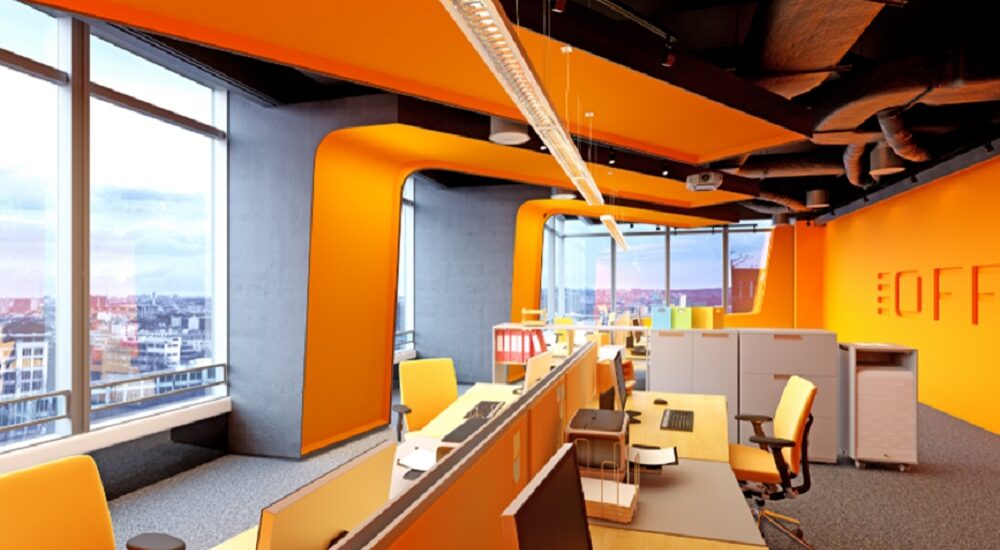The significance of colour in influencing the atmosphere of an environment cannot be overstated.
Colour serves not only to beautify the space but also to profoundly affect productivity, emotional state, and general well-being—particularly in office environments.
Examine the vital role of colour in interior office design, highlighting how it can be purposefully employed to foster a functional and motivating workplace.
Understanding the Psychological Impact of Colour
Colour psychology is a well-established field that examines how different hues affect human emotions and behaviour. Understanding this psychology is essential to creating office spaces that foster productivity and positivity.
- Blue for Focus and Calmness: Blue is often associated with calmness and clarity. It is an ideal colour for spaces requiring concentration and focus, such as private offices or meeting rooms. Blue tones can help reduce stress and create a serene environment, making it easier for employees to focus on tasks.
- Yellow for Creativity and Energy: Yellow is a vibrant colour that stimulates creativity and energy. It is often used in areas where brainstorming and creative thinking take place. Incorporating yellow in an office’s interior design can boost morale and encourage innovative ideas, making it suitable for design studios or collaborative spaces.
- Green for Balance and Relaxation: Green represents balance and tranquillity. It is a versatile colour that can be used throughout an office to create a refreshing and relaxing atmosphere. Green is particularly effective in spaces where employees need to rejuvenate, such as break rooms or lounge areas.
- Red for Stimulation and Action: Red is a powerful colour that evokes excitement and urgency. Red accents can stimulate energy and drive in areas requiring quick decision-making and action. It’s best suited for dynamic spaces like sales floors or activity zones.
The Role of Neutral Colours in Office Design
Neutral colours such as white, grey, and beige are staples in interior office design due to their versatility and timeless appeal. These colours provide a balanced backdrop that allows other design elements to shine without overwhelming the space.
- White for Cleanliness and Openness: White is synonymous with cleanliness and openness. It makes spaces appear larger and more inviting, which is particularly beneficial in smaller offices. White walls and ceilings can reflect light, making the office brighter and more conducive to productivity.
- Grey for Sophistication and Stability: Grey is a neutral tone that exudes sophistication and stability. It is popular in modern office designs, offering a sleek and professional look. Grey can be combined with other colours to create a balanced and cohesive office environment.
- Beige for Warmth and Comfort: Beige is a warm, neutral colour that adds comfort and cosiness to an office space. It is an excellent choice for creating a welcoming environment, particularly in reception areas or client-facing spaces. Beige works well with various other colours, making it a versatile option in office interior design.
Strategic Use of Accent Colours
Incorporating accent colours in interior design for offices can create visual interest and highlight specific workspace areas. Accent colours can be used on feature walls, furniture, or décor to add personality and energy to the space.
- Feature Walls: A feature wall painted in bold hues can serve as a focal point in the office, drawing attention and adding depth to the space. This technique is particularly effective in open-plan offices, where it helps define different zones without requiring physical barriers.
- Furniture and Décor: Accent colours can also be introduced through furniture and décor. For example, brightly coloured chairs, rugs, or artwork can create vibrancy in an otherwise neutral office environment. This approach allows for flexibility, as accent pieces can be easily changed to update the office’s look without a complete redesign.
- Brand Colours: Incorporating a company’s colours into the office design can reinforce brand identity and create a cohesive visual experience. This can be achieved through painted walls, custom furniture, or branded décor items. Using brand colours strategically in interior office design can also foster a sense of belonging among employees and leave a lasting impression on clients and visitors.
Balancing Colour with Office Lighting
A colour’s effectiveness in office interior design is heavily influenced by the space’s lighting. Natural light enhances the true colours of office interiors, while artificial lighting can alter how colours appear. It is essential to consider the lighting when selecting colours for an office to ensure the desired effect is achieved.
- Natural Light: Maximising natural light in an office space can enhance the impact of colour, making the environment feel more vibrant and lively. Large windows, glass partitions, and open spaces can help bring in more natural light, allowing colours to appear brighter and more authentic.
- Artificial Light: The artificial lighting in an office also affects colour perception. Warm lighting can make colours appear softer and more inviting, while cool lighting can make them seem sharper and more stimulating. Choosing a light that complements the colour scheme is necessary to create a harmonious office environment.
Conclusion
Colour is a significant element in interior design for offices, possessing the ability to convert a workspace into an environment that fosters productivity, inspiration, and warmth. Companies can develop visually appealing office settings while simultaneously promoting employee well-being and efficiency by recognising the psychological effects of various colours and employing them intentionally. The deliberate use of soothing blues, invigorating yellows, or balanced greys is vital in the thoughtful design of office interiors, contributing to the establishment of a functional and visually attractive workplace.
Contact RAW Design Consultants to discover how we can design an office space that perfectly reflects your brand and meets your unique needs.




